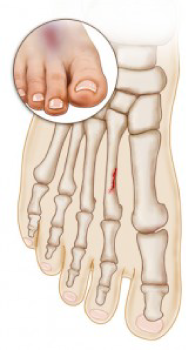Connect With Us
Blogs
vendor
Alcohol Sclerosing for Morton’s Neuroma

Many people experience foot pain without an apparent injury, and many of them are left wondering why. In many cases, the culprit is a neuroma. Simply put, a neuroma is a swollen nerve. In the case of a Morton’s neuroma, this nerve is located between the third and fourth toes. This condition can be quite painful, with most patients reporting a sharp feeling in the ball of the foot and radiating outward to the toes. There are many treatment options available to reduce the swelling in the nerve, among them a cutting-edge technique known as alcohol sclerosing.
Conservative care – including the use of custom orthotics, massage, and cortisone injections – is usually the first course of treatment for this painful condition. In the past, neuromas that failed to respond to these methods were typically removed surgically. However, because it is a nerve, patients who had them removed often complained of strange sensations in the place where the nerve used to be. Now, alcohol sclerosing can provide a preferable alternative to these older methods.
Using a solution of local anesthetics and ethyl alcohol, the doctor administers a series of injections near the affected nerve using ultrasound guidance. These injections are usually administered on a weekly basis over the course of three to seven visits. At this point, many patients report that they are completely pain free. Additional injections after this initial course of treatment are usually withheld for at least 90 days. This is because the effects of alcohol sclerosing can be gradual and need to be evaluated over time.
Dr. Aslmand has performed hundreds of these procedures, with the vast majority of his patients reporting an improvement in their condition. He prefers to use this treatment when possible because of its high success rate and relative safety when compared to surgical methods. If you are experiencing unexplained nerve pain in your foot, schedule an appointment to meet with Dr. Aslmand today. You too can benefit from the relief that countless others have enjoyed. Call today.
3 Common Treatments for Cracked Heels

During the winter months, feet are often covered with thicker socks and cramped into more insulated shoes. While this can keep your feet warm and cozy, it can also lead to dry and irritated skin. As skin dries, it can become cracked and callus and can require some attention to ensure that any problems do not get out of hand.
The reason that cracked heels happen is because the skin gets dry and as pressure is put on them from walking, running or any type of activity, the heel’s skin expands and the dry skin begins to split. This may seem like a minor issue; however cracked heels can lead to more serious problems if an infection is to occur.
To resolve this issue, cracked heels need to absorb moisture to prevent further skin separation, soreness, bleeding and potential infection. Below are 3 quick and easy ways to turn the tide on skin cracking in your heels:
Begin Using A Foot Cream
Getting moisture into the cracked skin is the most effective way to soothe the irritation and get your skin back to normal. We recommend Jergens or Gold Bond Foot Cream for mild cracking or Eucerin for severe cracking. All three products can be found at your local drugstore and are generally cost under $10. Once you have the foot cream, apply it to your heels twice a day, preferably right after you finish drying off from a bath or shower. This will provide the best rate of absorption. Give your moisturized feet 3-5 minutes for the cream to absorb into the skin before putting on socks or shoes.
Cut Back On Washing Your Feet
Washing your feet is an important way to maintain foot health, but too much soap and scrubbing can actually cause more harm than good. Soap will not only kill bacteria on your foot, but it will also remove layers of dense, calloused skin that keeps your foot protected. Instead of washing your feet daily, try washing them every other day, or use a mild cleanser that won’t strip away layers of your skin. As the moisture in your feet returns to normal and the cracking eases, you may return to washing your feet with more regularity.
Drink Plenty of Water to Stay Hydrated
It may not seem like it, but drinking plenty of water helps to hydrate your skin to keep it healthy and free from cracking. During the winter months, your body may not be showing typical signs of dehydration, but it is easy to forget to drink water. As the weather gets cold we are more likely to drink hot coffee or other warm beverages which can actually deplete the body of the water that keeps it hydrated. Drinking water throughout the day will help your skin fight back against dryness. Drinking 3-4 liters of water will help keep your skin hydrated and help your body maintain optimal health.
Cracked heels are a pain that many people deal with, but are also an easy to treat condition. If your cracked heels don’t recover after two weeks of implementing the treatments described above, contact our office and schedule time to see Dr. Aslmand to ensure that the issue gets under control before becoming more serious.
Three Tips for a New Year of Running

New Year’s resolutions, especially those that involve improving your health, can be a great thing. Of course, we all know how difficult it can be maintain our newfound good habits. What starts with the best of intentions too often ends in regret and frustration. But for those of you who are resolving to run more in the coming year, we want to offer some tips to help you keep it up and get the most out of one of the healthiest hobbies you’ll ever take up.
Set a series of goals and stick to them. Setting goals allows us to track our progress and can greatly enhance the feeling of accomplishment that comes from improving your fitness level. Setting both long- and short-term goals can make the whole process that much easier. At the daily level, set up a routine that you can stick to; try to run at the same time every day that you run, which should be a minimum of three days a week for most people. Every month, try to set a new goal in either the distance or amount of time that you run. Pushing yourself over time helps keep it interesting and fun.
Make sure you have the right equipment. Although running is one of the best exercises you can do, it can also lead to a number of injuries (as we know all too well). Proper running shoes are, of course, essential. But most people are also well-served by custom orthotics. We can make a pair of custom orthotics designed just for your feet, giving you the support and protection for optimal foot and ankle health.
Sign up for a race. There are numerous events every year in most cities, with varying degrees of competitiveness. Whether you choose to do a fun run or engage in some serious competition, having a race to look forward to can help keep you motivated and encourage you to reach new levels of fitness.
However you choose to approach your New Year’s resolutions, no matter what they are, we wish all of you the best of luck in 2014. And for those of you who do choose to run, we’ll be here to help keep you on your feet.
Torn Ligament in Ankle: What Does It Feel Like?

Torn Ligament in AnkleLiving a fun- and activity-filled life is an ideal and healthy goal to aim for. Whether it’s a leisurely stroll in the park, a challenging hiking trip in a forest on uneven terrain, or simply playing with your children in the backyard, your ankles are working hard to support your weight and freedom of movement. Unfortunately, one careless step, or a momentary loss of balance is enough to lead to sudden traumatic injury, causing sprain, rupture, or in severe cases, torn ligament in ankle.
What Are Ligaments and How Do They Work?
Your ankle bones are held together by three strong, elastic bands of connective tissue, the ankle ligaments. Their purpose is to provide support for the bones, while offering a wide range of delicate motions to your feet. Their health is vitally important to allow walking, running, and other weight-bearing physical activities.
What Happens When Ankle Ligaments Are Injured?
Unexpected, sudden twist of your ankle can lead to stretching and tearing of the ligaments, causing various degrees of trauma. In mild cases, the ankle joint is sprained with only minor damage present, however if the injury is severe, your ligaments could partially rupture, or even end up being completely torn.
What Does Torn Ligament in Ankle Feel Like?
When dealing with potential ligament injury, you should look for the following symptoms:
the most common sign of torn ligament in ankle is pain of varying degree; serious discomfort being extremely likely
you may experience swelling and bruising around the affected ankle
standing and putting weight on the injured foot becomes difficult, even impossible
in severe cases, you may have heard a popping sound during your accident
When ligaments are torn, your symptoms are unlikely to improve on their own in the hours following the injury. It is impossible to tell the severity of the damage simply judging from what you feel and see; medical evaluation is almost always necessary.
How Will My Ankle Injury Be Evaluated and What Are My Treatment Options?
During your visit, your medical professional will likely request an x-ray to have a better idea about the extent of your ankle injury. If your ligaments are torn, resting your ankle is vitally important. In order to immobilize the affected joint, an ankle brace may be worn for a period of time to help the ligaments heal, and to provide stability for the ankle. In the meantime, ice and compression may help to relieve the swelling, and elevating your foot will ensure that your ankle receives the proper rest it needs during the healing process. Surgery of the torn ligaments is rarely needed. Unless you experience repeated ankle trauma, your ligaments should heal on their own, provided that the advice of your medical professional is being followed. However, should this injury occur too frequently, surgical tightening of the ligaments may become necessary.
How Long Before I Can Return to My Previous Activities?
While torn ankle ligaments may heal relatively quickly, the gradual rehabilitation of the affected joint is very important. Ask your podiatrist’s advice, start slowly, and move gently. Daily stretching and strengthening exercises are a great way to increase the range of motion until you are able to bear weight on your foot, and movement becomes pain-free once again. This may take a few weeks depending on the severity of your injury, but by following these guidelines and consulting your podiatrist, you can ensure that you will be back to your previous activities quickly and without complications.
How To Tell If You Have a Stress Fracture In Your Foot

Foot Arthritis Doctor Long Beach
Foot Stress FractureA stress fracture is severe bruising or a small crack in the bone. These injuries are common among runners and also athletes who are involved in running sports like basketball and soccer. Stress fractures arise when a person changes their activities. Fractures can also occur when a person is suffering from osteoporosis or some similar disease that weakens their bones. To determine whether you have a stress fracture in your foot, you need to know where it is likely to occur, what causes it, the symptoms associated with this injury, and conditions that mimic stress fractures.
Where Do Stress Fractures Affect?
Stress fractures affect the metatarsals in your foot. When walking or running, the metatarsals are the main areas that are greatly impacted. Stress fractures can also occur in the heel, the outer bone of your ankle and lower leg, the small bone in your ankle joint, and the bone above your mid-foot.
What Causes a Stress Fracture?
A majority of stress fractures are regarded as overuse injuries. Overuse fractures arise when an athletic activity or movement is repeated often. The supporting muscles and weight-bearing bones in your foot do not have sufficient time to heal during exercise sessions.
Another cause of stress fracture is the interruption of the bone’s remodeling process. Your bones are constantly in a state of turnover. This means that new bone is always been replaced by older bone. When an athlete’s activity is excessively great, the older bone breaks down rapidly and outpaces your body’s ability for repairing and replacing it. This causes your bone to grow weak and susceptible to stress fractures.
Many cases of stress fractures arise when a person increases their physical activity. Such an increase can be the result of the frequency of a particular activity like increasing the days you exercise in a given week. It may also be in the form of increasing the intensity or duration of an activity like running for a longer period of time.
Bone fractures can also be caused by conditions like osteoporosis. These conditions decrease your bone’s density and strength making you more vulnerable to a stress fracture.
What Are The Symptoms Of A Stress Fracture?
The most common way to identify a stress fracture in your foot is pain. You will experience pain that develops slowly and gets worse when you continue engaging in weight bearing activities. The other symptoms you should watch out for include:
Pain that goes away when you rest
Pain that intensifies as you engage in your normal activities
Swelling on the exterior part of your ankle or above your foot
Bruising
Tenderness at the area of the foot that is causing you pain
What Conditions Are Easily Confused With Stress Fractures?
Some of the conditions you can mistake for a stress fracture are:
Sprains: These damage the ligament that stabilize your foot joint
Strains: These damage your muscle ortendon
Referred pain from the back: These include conditions such as arthritis or sciatica in the low back of your foot
Morton’s neuroma: This is a growth that affects the nerve that lies between the third and fourth toes of your foot.
Summing It Up
If you suspect you are suffering from a stress fracture, and the pain persists even after you rest or apply first aid, you need to consult a doctor. Your doctor may use surgical or non-surgical methods to relieve the pain. However, many cases of stress fractures are relieved by elevating the foot, placing ice on the affected area, or taking a break from rigorous activity.
3 Tips For Choosing The Right Podiatrist

Long Beach Podiatrist
3 Tips For Choosing The Right Podiatrist
If you are suffering from a foot injury, you need to seek professional care to ensure your current state does not escalate and become a serious medical condition. Podiatrists are medical experts who specialize in foot care. With so many podiatrists available today, picking the right one can be a pain stacking endeavor. Here are three tips that will help you choose best podiatrist in long beach.
Credentials
When looking for the best podiatrist near me, you need to verify their credentials. Not only should a podiatrist be licensed to practice, they should also have the appropriate training. Although podiatrists go through a bachelor’s degree, they are not all the same. There are podiatrists with special skills and training in different areas like high-risk management, sports, surgery, and pediatrics. Therefore, you need to determine a podiatrist’s specialized training or skills to decide whether they are qualified to treat your condition. Your general doctor can help you narrow down the particular skills required for your specific ailment.
Apart from reviewing a podiatrist’s training, you need to check their background. Find out what other cases they have dealt with and their success rate. Determine how long a podiatrist has been practicing and their reputation among the medical fraternity. These queries will not only help you find the right professional but will almost guarantee you the highest quality of treatment.
Techniques
When it comes to foot care, the procedures adopted by the best podiatrist in long beach make a whole lot of a difference. One of the things you need to look out for when picking a podiatrist is the procedures they offer. The more techniques a podiatrist uses, the higher the chance of resolving your problem. The ideal podiatrist should have state of the art equipment for treating different foot conditions. They should also be skilled in applying different methods of treatment.
Charges
When looking for the best podiatrist near me, you should be keen on their charges. Conducting an online search or seeking recommendations from your doctor will help you generate a list of the best podiatrists and the rates of their services. While you should not compromise on quality because of price, it smart to seek out a podiatrist with an affordable treatment plan. When you find a foot care professional who offers friendly prices, ensure they have standard treatment facilities, are licensed, and have the full expertise to treat your condition.
Finding the right podiatrist in long beach is no easy undertaking. You need to bear in mind the potential candidate’s training, treatment options, and charges. You will never go wrong when you conduct your search for a podiatrist guided by these three simple tips.
Do I Need to See a Podiatrist for Corns?

Corns are one of the top foot conditions that podiatrists see. They’re not contagious, but they can be unsightly and uncomfortable and often leave sufferers combing the internet for home remedies to relieve them. Though corns generally aren’t a serious problem, there are several good reasons to see a podiatrist for corns to ensure that they’re treated safely and effectively.
What are corns?
Corns are similar to calluses, in that they’re areas of hardened skin developed to protect parts of the body.
Hard corns are typically located on the tops or outsides of toes, and have a firm, dense center.
Seed corns show up on the heels and balls of feet, and resemble plugs of hardened skin.
Soft corns are usually found between toes, and are smooth and tender.
While calluses arise in areas subject to friction, corns develop in areas subject to pressure.
Can corns be treated at home?
Many people find themselves asking, “Can I treat the corns on my feet myself?” Unfortunately, this is often not the case. DIY remedies usually involve ingredients like lemon juice in an attempt to soften the hardened skin, or even cutting the corn off at home. These measures may not completely remove the corn, increase the odds of infection, and don’t do anything to prevent its recurrence.
Is it necessary to see a podiatrist for corns?
It’s a good idea to have corns treated by a professional. If they are cut or scraped, they can easily become infected. This is a particular risk in people with diabetes, heart disease, or poor circulation. Sometimes, corns may begin to discharge fluid on their own. This is typically a sign of infection, and warrants a doctor’s visit. In the office, a podiatrist can trim the corn and offer advice to keep it from coming back.
For corn sufferers wondering, “Should I visit a podiatrist for the corns on my feet?” The answer is: Probably. It is best to schedule a consultation to determine the extent of the corn just to be sure. Corns generally aren’t a serious problem, but they can become very uncomfortable and can be quickly and easily taken care of during a podiatrist’s office visit. To schedule a consultation with Advanced Foot and Ankle Center give our office a call at 562-426-0376.
Difference of a Midfoot Sprain Versus Lisfranc Injury

Midfoot Sprain Vs Lisfranc InjurySometimes, they are referred to as midfoot sprains that usually need a long time of recovery. Lisfranc injury also involves any joint dislocation, fracture combination and injury to stabilize joint ligament.
A damaged part is the connection of the forefoot and midfoot. Significant disruptions of midfoot ligaments typically lead to chronic pain or immediate swelling, and inability of lifting heavy weight objects. That is especially happen when there are superimposed fractures in the bones of the midfoot. During normal walking or standing, the ligament of your midfoot is subject to body weight forces. The bones and the ligament must be treated before the occurrence of normal walking. However, healing usually takes a couple of months, before it returns to the normal position.
What is Midfoot Sprain?
Midfoot sprains are damages or injuries to the ligament of the foots’ central region or the midfoot. This type of injury is very common that usually occurs during physical activities or athletic, especially those types of sport that involves twisting & cutting that might lead to injury.
When you fall, stumble or your foot turns oddly, such incidents can also lead to midfoot sprain. Midfoot sprain can cause athletes to miss their time season, as it is not just a simple sprain. Midfoot sprain also involves tearing of the ligament, fibrous structures that connect the bone.
How Can You Classify Midfoot Sprain?
Classifying a midfoot sprain may not be easy for some, especially if it is just your first time to encounter such kind of injury. Midfoot sprain is most commonly momentary elasticity of the ligament, which subsequently starts to the original length. That is therefore called as grade one injury.
Less common and more severe injuries are most likely lead to grade two or even grade three or complete ligament rupture. In that case, the injuries of the midfoot are more severe because the ligament is not returning to the original length, causing the bones to separate from one another. This is also referred to the unstable injury, which usually need a serious treatment or surgery.
What is a Lisfranc Sprain?
A Lisfranc center region of foot is a name of the midfoot of individuals. The region contains several small bones that form an arch of your foot. The bones of your Lisfranc are very important, as they have specific roles to give support & stability to the feet. Furthermore, Lisfranc injuries or sprains should be taken seriously as they can really affect the normal function your feet.
Importance of Immediate Treatment
Whether it is Lisfranc injury or midfoot sprain, it is very important to treat them immediately and appropriately. In most cases, these types of injuries or damages can cause big problems and become permanent, once not treated early. A person with Lisfranc injury or midfoot sprain might not return the normal function of the foot, especially when the ligaments or any bones of the Lisfranc gets sprained and torn. Swelling, persistent pain, bruising and severe pain are also involved. So, if ever you encounter this kind of injury or sprain in your feet, make sure to treat them earlier to prevent serious injuries.
4 Ways to Build Ankle Strength

Strong AnklesAnkle sprains are one of the most common conditions injuries. The good thing is that it can possibly be avoided by enhancing your ankle strength. There are also many benefits attached in maintaining healthy and strong ankles. Healthy and strong ankles can definitely improve your legs and balance.
Perhaps, most of you think that ankle exercise is just for the athletes. Well, you are wrong, as even regular individuals can do a lot of ways to build ankle strength. Exercise can help you a lot and can be performed while watching TV or sitting down. You can even strengthen your ankles when adding weight for bigger challenge. Working on or stretching your balance could also build ankle strength.
Working out while Sitting
Performing ankle turn is one of the most effective ways that you can do to strengthen your ankles. Apart from that, it is also one easy way of ankle exercise that you can perform. While sitting in your chair, just slide the exercise band or jump rope under a single foot. Then, pull the rope/band to pull your ankle.
After doing that, push against bands’ force and slightly turns your ankle. The bands or the rope are stretching materials that have wider range of movement, that’s why they are very effective to use for strengthening your ankle. You can do it repeatedly as many as you can. You can also use old-shirt if no available jump rope or rubber band.
Performing exercise while standing
This type of ankle exercise is so easy, where you can try your toe raises. If you feel weak or you have issues in proper balancing, you can do this ankle work out placing your back on the wall. Make sure that you are not using anything that has overly weight in your hand while performing the exercise.
Stretching your ankle
This is another way of exercise that you can do to build your ankle strength. Place both of your hands on the wall for about shoulder heights, then prop your right ball touching the wall. You can always repeat doing this type of ankle exercise if you want. Once you experience ankle sprains, you have to immediately check them to prevent possible defects or any serious injury.
Practice Your Balance
Practicing your balance is also one of the most effective ways of exercise that can definitely improve your ankle strength. Stand on the pillow or wobble board with legs that are slightly closer than the shoulder width. After that, squat down in a slowly manner while controlling your squats’ speed.
Then, slowly go back to your standing position. It is best recommended to perform this exercise for about ten squats every in every set. You can repeat doing the set three times or more depending on your ankle strength. If you know more different ways of ankle exercise, you can add them on your list.
Strengthening your ankle is very important to be done now. It will not only help you to be more physically active, but can even enhance your physical performance.
How to Diagnose a Sprained Ankle Compared to a Broken Ankle?

Sprained AnkleBoth sprained ankle and broken ankle are painful and can result from the same injuries. However, these two different fractures are treated differently.
A person with sprained ankle can walk with a foot, but carefully & with pain. Sprained ankles are injuries that occur when you twist, turn or roll your ankles in awkward way, especially during physical activities.
Once it happen, this can tear and stretch the bands of ligaments which help to hold together the bones of your ankle. Ligaments help to stabilize your joints and preventing from excessive movement.
When ligaments around the ankles are push and past these limitations, it can cause sprain. This fracture, commonly involves injury to the ligament outside the ankle. You might have sprained ankle when you notice these symptoms in your ankle.
Common Symptoms of Ankle Sprain
Stiffness
Pain
Skin discoloration
Tenderness
Swelling
Bruising
The ankles can sustain a lot of different injuries. That’s why it’s very necessary to see a doctor when you experience such problems in your ankle. A doctor can figure out whether your injury is something severe or a sprain. Doctors can perform physical examination in order to find out which ligaments are torn. In the exam, a doctor will move the ankle joints in different ways in order to check the range of action.
Imaging tests, like X-ray is also perform to ruled out the bone fracture. When the doctor suspect bone chipping, damage the ankle joints surface and serious injuries to ligaments, an MRI may also be done. The MRI exam uses strong magnetic and radio waves in order to make detailed image of one’s’ body, allowing the doctor to create proper diagnosis for your sprained ankle.
Sprained ankles are injuries where there’s disruption and tear of ligaments. While broken ankle is any crack, chip and break in your ankle bone. This fracture of your ankle does not only affect the bone ankle but, including the talus, fibula and tibia. Broken ankle is typically due to stressing your ankle joint.
Ligaments may even tear down and the ankle get fractured. This type of ankle fracture can occur because of rolling in and out of the ankle. Apart from that, twisting it side by side, joint extending or extreme flexing are also other reasons of broken ankle.
Common Symptoms of Broken Ankle
Numbness
Swelling
Deformities of bones surrounding the ankle
Bruising
Pain
Pale tissues
One of the most important thing to do when you are experiencing these signs and symptoms, is to consult a doctor. Broken ankles are more serious than sprained ankles and they need to be treated immediately. A physical examination and X-ray are needed to be done in diagnosing a broken ankle.
Treatment may also include taping, booting, casting, wrapping, or surgery. The recovery period for those patients with broken ankles commonly last for four to eight weeks, allowing the ankle bones to be heal. Several months are needed to regain the full movements of ankle joints. But those patients with severe fractures that require surgery make take lots of time to be heal.

